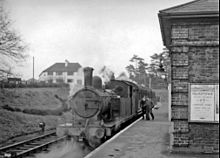Ongar railway station
[2] Although the rest of the branch was electrified by London Underground before operations were taken over from British Railways, trains on the section north of Epping continued to be hauled by steam locomotives as a separate shuttle service.
[3] The low power supply prevented the Epping to Ongar section being fully integrated into the line and it continued to operate as a shuttle service.
[4] The entire Epping to Ongar branch was a single track line with one passing place at North Weald station, although this loop was taken out of service between 1888 and 1949, and again from 1976.
For much of its latter years, the service only operated during Monday to Friday peak hours, and London Transport closed Blake Hall station, the least used on the entire system, in 1981.
The station and the line are now in the ownership of a private company, Epping Ongar Railway Ltd who, at time of purchase, publicly stated their intention to run commuter services again, but the claimed lack of platform availability at London Underground's Epping station at the west end of the line has to date proven an insuperable obstacle to this.
These are designed with the long-term future of the branch and to enable the use of locomotive-hauled trains (hauled by steam and diesel locomotives), all in keeping with its use as a heritage railway.
[7] The sand drag at the very end of the rails — intended to help slow trains that overshot the stopping mark — was said to be home to a breed of harmless scorpion and featured in a 1979 episode of the BBC's Wildlife on One.





